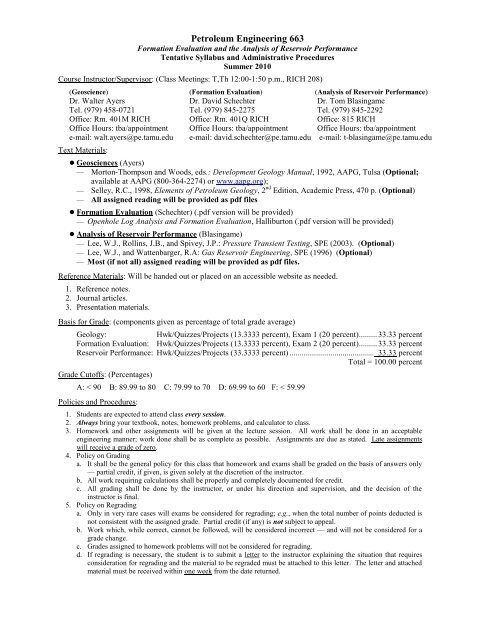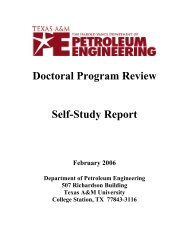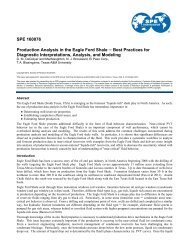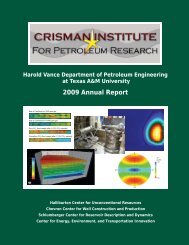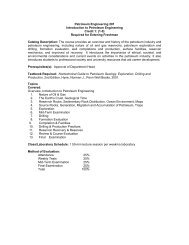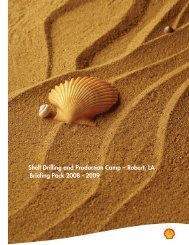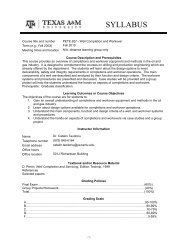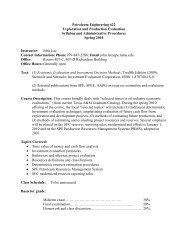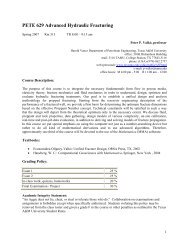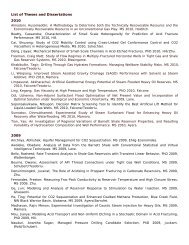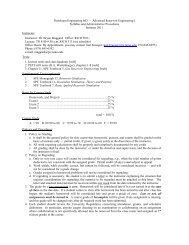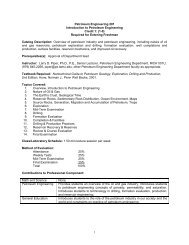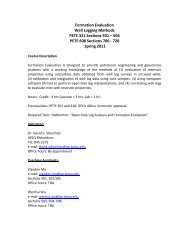PETE 663 Formation Eval. & Analysis of Reservoir Performance
PETE 663 Formation Eval. & Analysis of Reservoir Performance
PETE 663 Formation Eval. & Analysis of Reservoir Performance
Create successful ePaper yourself
Turn your PDF publications into a flip-book with our unique Google optimized e-Paper software.
Petroleum Engineering <strong>663</strong><br />
<strong>Formation</strong> <strong>Eval</strong>uation and the <strong>Analysis</strong> <strong>of</strong> <strong>Reservoir</strong> <strong>Performance</strong><br />
Tentative Syllabus and Administrative Procedures<br />
Summer 2010<br />
Course Instructor/Supervisor: (Class Meetings: T,Th 12:00-1:50 p.m., RICH 208)<br />
(Geoscience) (<strong>Formation</strong> <strong>Eval</strong>uation) (<strong>Analysis</strong> <strong>of</strong> <strong>Reservoir</strong> <strong>Performance</strong>)<br />
Dr. Walter Ayers Dr. David Schechter Dr. Tom Blasingame<br />
Tel. (979) 458-0721 Tel. (979) 845-2275 Tel. (979) 845-2292<br />
Office: Rm. 401M RICH Office: Rm. 401Q RICH Office: 815 RICH<br />
Office Hours: tba/appointment Office Hours: tba/appointment Office Hours: tba/appointment<br />
e-mail: walt.ayers@pe.tamu.edu e-mail: david.schechter@pe.tamu.edu e-mail: t-blasingame@pe.tamu.edu<br />
Text Materials:<br />
• Geosciences (Ayers)<br />
— Morton-Thompson and Woods, eds.: Development Geology Manual, 1992, AAPG, Tulsa (Optional;<br />
available at AAPG (800-364-2274) or www.aapg.org);<br />
— Selley, R.C., 1998, Elements <strong>of</strong> Petroleum Geology, 2 nd Edition, Academic Press, 470 p. (Optional)<br />
— All assigned reading will be provided as pdf files<br />
• <strong>Formation</strong> <strong>Eval</strong>uation (Schechter) (.pdf version will be provided)<br />
— Openhole Log <strong>Analysis</strong> and <strong>Formation</strong> <strong>Eval</strong>uation, Halliburton (.pdf version will be provided)<br />
• <strong>Analysis</strong> <strong>of</strong> <strong>Reservoir</strong> <strong>Performance</strong> (Blasingame)<br />
— Lee, W.J., Rollins, J.B., and Spivey, J.P.: Pressure Transient Testing, SPE (2003). (Optional)<br />
— Lee, W.J., and Wattenbarger, R.A: Gas <strong>Reservoir</strong> Engineering, SPE (1996) (Optional)<br />
— Most (if not all) assigned reading will be provided as pdf files.<br />
Reference Materials: Will be handed out or placed on an accessible website as needed.<br />
1. Reference notes.<br />
2. Journal articles.<br />
3. Presentation materials.<br />
Basis for Grade: (components given as percentage <strong>of</strong> total grade average)<br />
Geology:<br />
Hwk/Quizzes/Projects (13.3333 percent), Exam 1 (20 percent) ......... 33.33 percent<br />
<strong>Formation</strong> <strong>Eval</strong>uation: Hwk/Quizzes/Projects (13.3333 percent), Exam 2 (20 percent) ......... 33.33 percent<br />
<strong>Reservoir</strong> <strong>Performance</strong>: Hwk/Quizzes/Projects (33.3333 percent) ......................................... 33.33 percent<br />
Total = 100.00 percent<br />
Grade Cut<strong>of</strong>fs: (Percentages)<br />
A: < 90 B: 89.99 to 80 C: 79.99 to 70 D: 69.99 to 60 F: < 59.99<br />
Policies and Procedures:<br />
1. Students are expected to attend class every session.<br />
2. Always bring your textbook, notes, homework problems, and calculator to class.<br />
3. Homework and other assignments will be given at the lecture session. All work shall be done in an acceptable<br />
engineering manner; work done shall be as complete as possible. Assignments are due as stated. Late assignments<br />
will receive a grade <strong>of</strong> zero.<br />
4. Policy on Grading<br />
a. It shall be the general policy for this class that homework and exams shall be graded on the basis <strong>of</strong> answers only<br />
— partial credit, if given, is given solely at the discretion <strong>of</strong> the instructor.<br />
b. All work requiring calculations shall be properly and completely documented for credit.<br />
c. All grading shall be done by the instructor, or under his direction and supervision, and the decision <strong>of</strong> the<br />
instructor is final.<br />
5. Policy on Regrading<br />
a. Only in very rare cases will exams be considered for regrading; e.g., when the total number <strong>of</strong> points deducted is<br />
not consistent with the assigned grade. Partial credit (if any) is not subject to appeal.<br />
b. Work which, while correct, cannot be followed, will be considered incorrect — and will not be considered for a<br />
grade change.<br />
c. Grades assigned to homework problems will not be considered for regrading.<br />
d. If regrading is necessary, the student is to submit a letter to the instructor explaining the situation that requires<br />
consideration for regrading and the material to be regraded must be attached to this letter. The letter and attached<br />
material must be received within one week from the date returned.
Petroleum Engineering <strong>663</strong><br />
<strong>Formation</strong> <strong>Eval</strong>uation and the <strong>Analysis</strong> <strong>of</strong> <strong>Reservoir</strong> <strong>Performance</strong><br />
Syllabus (Continued)<br />
Summer 2010<br />
Policies and Procedures: (Continued)<br />
6. The grade for a late assignment is zero. Homework will be considered late if it is not turned in at the start <strong>of</strong> class on<br />
the due date. If a student comes to class after homework has been turned in and after class has begun, the student's<br />
homework will be considered late and given a grade <strong>of</strong> zero. Late or not, all assignments must be turned in. A<br />
course grade <strong>of</strong> Incomplete will be given if any assignment is missing, and this grade will be changed only after all<br />
required work has been submitted.<br />
7. Each student should review the University Regulations concerning attendance, grades, and scholastic dishonesty. In<br />
particular, anyone caught cheating on an examination or collaborating on an assignment where collaboration is not<br />
specifically allowed will be removed from the class roster and given an F (failure grade) in the course.<br />
Specifically, you are NOT AUTHORIZED to collaborate any individual assignment, exam, quiz, etc.; this includes<br />
discussions, sharing materials, etc. You are expressly FORBIDDEN from such actions on any and all assignments.<br />
You are only permitted to collaborate on assignments if the instructor specifically authorizes such collaborations, and<br />
then for only for the assignment where such collaboration is authorized. Failure to abide by this guideline will invoke<br />
an F (failure grade) in the course or on the assignment, at the discretion <strong>of</strong> the instructor, based on the severity <strong>of</strong> the<br />
infraction.<br />
Course Description<br />
The purpose <strong>of</strong> this course is to provide the student with a working knowledge <strong>of</strong> the current methodologies<br />
used in geological description/analysis, formation evaluation (the analysis/interpretation <strong>of</strong> well log data),<br />
and the analysis <strong>of</strong> well performance data (the design/analysis/interpretation <strong>of</strong> well test and production<br />
data). The overall course objective is to provide the student with the ability to assess field performance and<br />
to optimize hydrocarbon recovery by analyzing/interpreting/integrating geologic, well log, and well<br />
performance data.<br />
Course Objectives<br />
The student should be able to perform the tasks given below for each course module.<br />
Course Module 1: Geosciences (Ayers)<br />
• Identify components <strong>of</strong> a petroleum system; name and describe the organic sources <strong>of</strong> hydrocarbons.<br />
• Describe the processes <strong>of</strong> thermal maturation, primary and secondary migration, and hydrocarbon trapping;<br />
name and describe 2 types <strong>of</strong> self-sourcing reservoirs.<br />
• Describe the origin and significance <strong>of</strong> structural features, including folds, fractures, and traps; describe<br />
unconformities; describe the methods and tools used for structural evaluations and modeling.<br />
• Explain and give examples <strong>of</strong> in-situ stress effects on absolute permeability and permeability anisotropy.<br />
• Characterize clastic and carbonate reservoirs by describing the geometry, orientation, and continuity <strong>of</strong><br />
sedimentary facies and their relations to flow units and reservoir quality.<br />
• List examples <strong>of</strong> diagenetic effects on clastic and carbonate reservoir quality.<br />
• Describe porosity-permeability relations in clastic and carbonate reservoirs; give examples <strong>of</strong> scalar effects on<br />
permeability determination.<br />
• Explain/describe stratigraphic traps.<br />
• Describe the methods, tools, and workflow for developing a reservoir model.<br />
Course Module 2: <strong>Formation</strong> <strong>Eval</strong>uation (Schechter)<br />
• Describe and explain the following operational aspects <strong>of</strong> open-hole logging:<br />
• Logging operations surface and downhole equipment.<br />
• Describe logging operation procedures.<br />
• Explain how to read a basic open-hole log from a standard triple combo tool.<br />
• Calculate volumetric estimate <strong>of</strong> original fluids in place<br />
• Explain and apply the principles <strong>of</strong> operation and interpretation <strong>of</strong> the following logs:<br />
• Gamma Ray: demonstrate calculation <strong>of</strong> Vshale, determine gamma ray response for commonly occurring<br />
rocks<br />
• Spontaneous Potential: demonstrate calculation <strong>of</strong> Vshale, demonstrate calculation <strong>of</strong> formation water<br />
resistitvity<br />
• Sonic: calculate sonic porosity, describe Rwa technique<br />
2
Petroleum Engineering <strong>663</strong><br />
<strong>Formation</strong> <strong>Eval</strong>uation and the <strong>Analysis</strong> <strong>of</strong> <strong>Reservoir</strong> <strong>Performance</strong><br />
Syllabus (Continued)<br />
Summer 2010<br />
• Neutron Density: describe gas and shale effect, determine neutron density crossplot porosity, determine<br />
lithology from neutron-density cross plot<br />
• Resistivity: describe resistivity measurements in terms <strong>of</strong> invasion diameter<br />
• Apply the following techniques to calculate water saturation:<br />
• Archie’s law<br />
• Pickett plot<br />
• Hingle plot<br />
• Shaly sand analysis<br />
Course Module 3: <strong>Analysis</strong> <strong>of</strong> <strong>Reservoir</strong> <strong>Performance</strong> (Blasingame)<br />
• Derive and apply the analysis and interpretation methodologies for pressure drawdown and pressure buildup<br />
tests — for liquid, gas, and multiphase flow systems (i.e., "conventional" plots and type curve analysis).<br />
Specifically, the following cases:<br />
• Apply dimensionless solutions ("type curves") and field variable solutions ("specialized plots") for the following<br />
well test analysis case cases:<br />
— Unfractured and fractured wells in infinite and finite-acting, homogeneous and dual porosity reservoirs, for<br />
constant rate and constant pressure cases.<br />
— Variable-rate convolution (specialized plots).<br />
— The pseudopressure and pseudotime concepts for the analysis <strong>of</strong> well test data for dry gas reservoir<br />
systems.<br />
• Analyze production data (rate-time or pressure-rate-time data) to obtain reservoir volume and estimates <strong>of</strong><br />
reservoir properties for gas and liquid reservoir systems. The student should also be able to make performance<br />
forecasts for such systems.<br />
• Demonstrate the capability to integrate, analyze, and interpret well test and production data to characterize a<br />
reservoir in terms <strong>of</strong> reservoir properties and performance potential (field study project).<br />
Date Topic Reading<br />
Tentative Schedule – may be revised<br />
Module 1: Geosciences (Ayers) Assignments, homework and reading materials will be posted in WebCT<br />
June 1 T (Geol) Introduction; petrol. systems; source rocks; therm. mature; HC migration WebCT, pdf<br />
June 3 Th (Geol) Geologic time and principles, trapping mech; seals; struct. styles and features WebCT, pdf<br />
June 8 T (Geol) Structural assessment and traps; folds and fractures; unconformities WebCT, pdf<br />
10 Th (Geol) Geophysical methods in petroleum evaluation WebCT, pdf<br />
15 T (Geol) Res. Characterization; stratigraphic analysis; clastic and carbonate<br />
depositional systems; stratigraphic traps<br />
WebCT, pdf<br />
17 Th (Geol) <strong>Reservoir</strong> properties and diagenesis WebCT, pdf<br />
22 T Geoscience Examination<br />
Module 2: <strong>Formation</strong> <strong>Eval</strong>uation (Schechter)<br />
June 24 Th (FrmEvl) Logging procedures and format; Basic lithology measurements: SP and GR Hall. Ch. 1-7; 9-10<br />
29 T (FrmEvl) Nuclear tools and interpretation basics; Acoustic tools Hall. Ch. 16-18<br />
July 1 Th (FrmEvl) Crossplots I — Lithology-related functions Hall. Ch. 20,22-23<br />
July 6 T (FrmEvl) Resistivity methods I — Principles Halliburton Ch. 11-14<br />
8 Th FrmEvl) Resistivity methods II — Advanced measurements; Halliburton Ch. 15<br />
Crossplots II — Saturation-related functions Halliburton Ch. 21,24,25<br />
13 T (FrmEvl) Shaly-sand evaluation — Causes and effects; interpretation Hall. Ch. 27; Handout<br />
15 Th <strong>Formation</strong> <strong>Eval</strong>uation Examination<br />
Module 3: <strong>Analysis</strong> <strong>of</strong> <strong>Reservoir</strong> <strong>Performance</strong> (Blasingame)<br />
July 20 T (ResPrf) <strong>Analysis</strong>/Interpretation <strong>of</strong> Well Test Data — "Conventional" Analyses Lee Ch. 1-3; Lee-Wat. Ch. 1,6<br />
22 Th (ResPrf) <strong>Analysis</strong>/Interpretation <strong>of</strong> Well Test Data — "Type Curve" Analyses Lee Ch. 4; Lee-Wat. Ch. 6<br />
27 T (ResPrf) <strong>Analysis</strong>/Interpretation <strong>of</strong> Well Test Data — Design/Integration/<strong>Analysis</strong> Lee Ch. 4; Lee-Wat. Ch. 6<br />
29 Th (ResPrf) <strong>Analysis</strong>/Interpretation <strong>of</strong> Prod. Data — Introduction; "Decline" Analyses Lee Ch. 5; Lee-Wat. Ch. 7,9<br />
August 03 T (ResPrf) <strong>Analysis</strong>/Interpretation <strong>of</strong> Production Data — "Type Curve" Analyses Lee Ch. 5; Lee-Wat. Ch. 7,9<br />
05 Th (ResPrf) <strong>Analysis</strong>/Interpretation <strong>of</strong> Production Data — Integration/Forecasting Lee Ch. 5; Lee-Wat. Ch. 7,9<br />
August 10 T Due date for submission <strong>of</strong> remaining project/homework materials.<br />
There is no comprehensive final examination for this course — the timeslot for the final examination will be used as the final due<br />
date for assignments related to the <strong>Analysis</strong> <strong>of</strong> <strong>Reservoir</strong> <strong>Performance</strong> (Module 3).<br />
3
Petroleum Engineering <strong>663</strong><br />
<strong>Formation</strong> <strong>Eval</strong>uation and the <strong>Analysis</strong> <strong>of</strong> <strong>Reservoir</strong> <strong>Performance</strong><br />
Required University Statements — Texas A&M University,<br />
Summer 2010<br />
Americans with Disabilities Act (ADA) Statement:<br />
The Americans with Disabilities Act (ADA) is a federal anti-discrimination statute that provides comprehensive civil<br />
rights protection for persons with disabilities. Among other things, this legislation requires that all students with<br />
disabilities be guaranteed a learning environment that provides for reasonable accommodation <strong>of</strong> their disabilities. If<br />
you believe you have a disability requiring an accommodation, please contact the Department <strong>of</strong> Student Life,<br />
Services for Students with Disabilities in Room B118 <strong>of</strong> Cain Hall, or call 845-1637.<br />
Aggie Honor Code: (http://www.tamu.edu/aggiehonor/)<br />
Definitions <strong>of</strong> Academic Misconduct:<br />
"An Aggie does not lie, cheat or steal, or tolerate those who do."<br />
1. CHEATING: Intentionally using or attempting to use unauthorized materials, information, notes, study aids or<br />
other devices or materials in any academic exercise.<br />
2. FABRICATION: Making up data or results, and recording or reporting them; submitting fabricated<br />
documents.<br />
3. FALSIFICATION: Manipulating research materials, equipment or processes, or changing or omitting data or<br />
results such that the research is not accurately represented in the research record.<br />
4. MULTIPLE SUBMISSION: Submitting substantial portions <strong>of</strong> the same work (including oral reports) for<br />
credit more than once without authorization from the instructor <strong>of</strong> the class for which the student submits the<br />
work.<br />
5. PLAGIARISM: The appropriation <strong>of</strong> another person's ideas, processes, results, or words without giving<br />
appropriate credit.<br />
6. COMPLICITY: Intentionally or knowingly helping, or attempting to help, another to commit an act <strong>of</strong><br />
academic dishonesty.<br />
7. ABUSE AND MISUSE OF ACCESS AND UNAUTHORIZED ACCESS: Students may not abuse or misuse<br />
computer access or gain unauthorized access to information in any academic exercise. See Student Rule 22:<br />
http://student-rules.tamu.edu/<br />
8. VIOLATION OF DEPARTMENTAL OR COLLEGE RULES: Students may not violate any announced<br />
departmental or college rule relating to academic matters.<br />
9. UNIVERSITY RULES ON RESEARCH: Students involved in conducting research and/or scholarly activities<br />
at Texas A&M University must also adhere to standards set forth in University Rule 15.99.03.M1 -<br />
Responsible Conduct in Research and Scholarship. For additional information please see:<br />
http://rules.tamu.edu/urules/100/159903m1.htm.<br />
Plagiarism Statement:<br />
The materials used in this course are copyrighted. These materials include but are not limited to syllabi, quizzes,<br />
exams, lab problems, in-class materials, review sheets, and additional problem sets. Because these materials are<br />
copyrighted, you do not have the right to copy the handouts, unless permission is expressly granted.<br />
As commonly defined, plagiarism consists <strong>of</strong> passing <strong>of</strong>f as one's own the ideas, words, writings, etc., which belong<br />
to another. In accordance with this definition, you are committing plagiarism if you copy the work <strong>of</strong> another person<br />
and turn it in as your own, even is you should have the permission <strong>of</strong> that person. Plagiarism is one <strong>of</strong> the worst<br />
academic sins, for the plagiarist destroys the trust among colleagues without which research cannot be safely<br />
communicated.<br />
If you have any questions regarding plagiarism, please consult the latest issue <strong>of</strong> the Texas A&M University Student<br />
Rules, http://student-rules.tamu.edu, under the section "Scholastic Dishonesty."<br />
4


